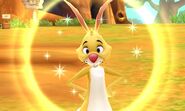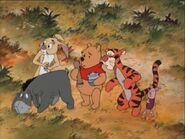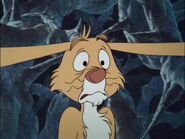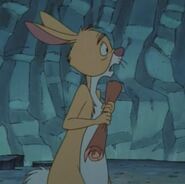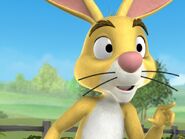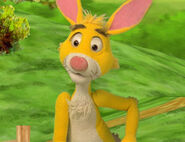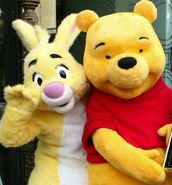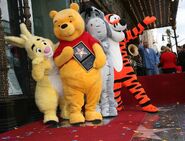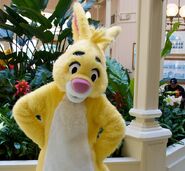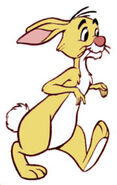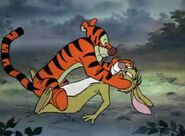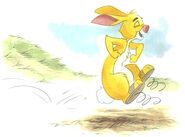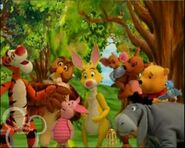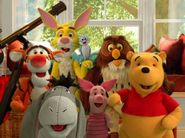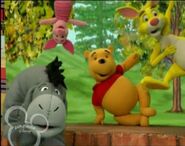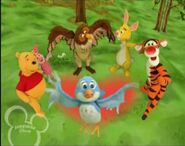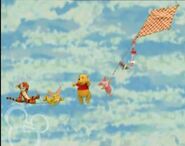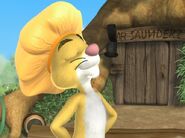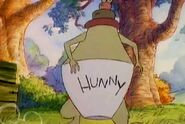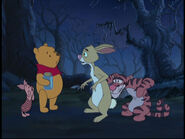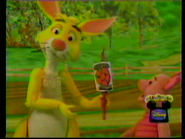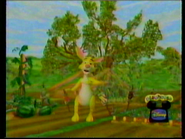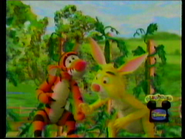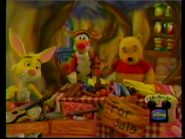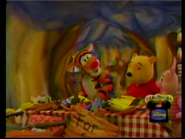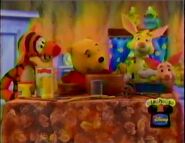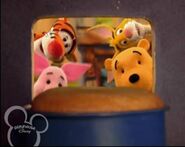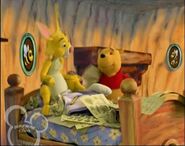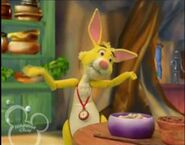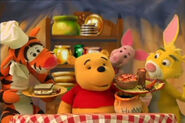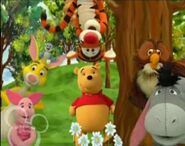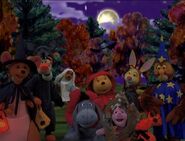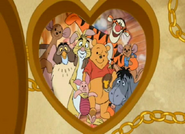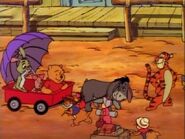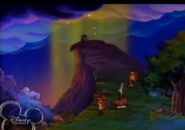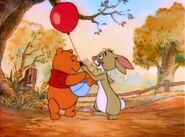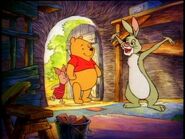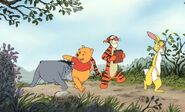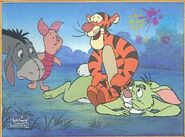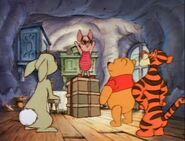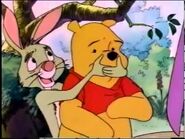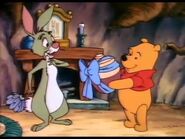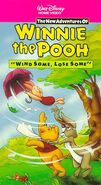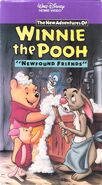Uptown2018 (talk | contribs) No edit summary Tag: Visual edit |
Uptown2018 (talk | contribs) No edit summary Tag: Visual edit |
||
| (16 intermediate revisions by 7 users not shown) | |||
| Line 1: | Line 1: | ||
{{Infobox |
{{Infobox |
||
|name = Rabbit |
|name = Rabbit |
||
| − | |image = |
+ | |image = Rabbit 2011.png |
|caption = Rabbit, as seen in Disney productions |
|caption = Rabbit, as seen in Disney productions |
||
|gender = Male |
|gender = Male |
||
| Line 8: | Line 8: | ||
|introduction = ''[[Winnie-the-Pooh (book)|Winnie-the-Pooh]]'' |
|introduction = ''[[Winnie-the-Pooh (book)|Winnie-the-Pooh]]'' |
||
|color = Yellow (except for ''[[The New Adventures of Winnie the Pooh]]'') <br>Green (in ''[[The New Adventures of Winnie the Pooh]]'') |
|color = Yellow (except for ''[[The New Adventures of Winnie the Pooh]]'') <br>Green (in ''[[The New Adventures of Winnie the Pooh]]'') |
||
| − | |performer = [[Junius Matthews]] ( |
+ | |performer = [[Junius Matthews]] (1966-1977) <br>[[Will Ryan]] (1983-1987) <br>[[Ken Sansom]] (1988-2010) <br>[[Jess Harnell]] (singing voice) <br>[[Ray Erlenborn]] <br>[[Tom Kenny]] (2011) |
| − | |quotes = "Oh my, oh my |
+ | |quotes = "Oh, my, oh, my." "Oh, dear, oh, gracious." |
| − | }}'''Rabbit''' is one of the animal inhabitants of [[The Hundred Acre Wood]] and one of the most important characters, appearing in almost all [[Winnie the Pooh]] stories. |
+ | |first = Winnie the Pooh (book)|title = Rabbit|second = The House at Pooh Corner|third = Return to the Hundred Acre Wood|fourth = Winnie-the-Pooh's Colors}}'''Rabbit''' is one of the animal inhabitants of [[The Hundred Acre Wood|the Hundred Acre Wood]] and one of the most important characters, appearing in almost all [[Winnie the Pooh]] stories. |
== In the books == |
== In the books == |
||
| − | The first appearance of Rabbit is in chapter II in the book ''[[Winnie-the-Pooh (Book)|Winnie-the-Pooh]]'' by [[A. |
+ | The first appearance of Rabbit is in chapter II in the book ''[[Winnie-the-Pooh (Book)|Winnie-the-Pooh]]'' by [[A.A. Milne]]. He also appears in chapters VII, VIII, IX and X of that book, as well as in chapters III, V, VI, VII, VIII, IX, and X in ''[[The House at Pooh Corner]]''. |
| − | Unlike most of the cast in the books, who are based on stuffed animals owned by [[Christopher Robin Milne]], the illustrations of Rabbit look more like a living animal than a stuffed one. This idea is also supported by Rabbit’s own comment to [[Owl]], "You and I have brains. The others have fluff." In [[Ernest H. Shepard]]’s illustrations, Rabbit appears like a typical |
+ | Unlike most of the cast in the books, who are based on stuffed animals owned by [[Christopher Robin Milne]], the illustrations of Rabbit look more like a living animal than a stuffed one. This idea is also supported by Rabbit’s own comment to [[Owl]], "You and I have brains. The others have fluff." In [[Ernest H. Shepard]]’s illustrations, Rabbit appears like a typical long-eared rabbit, except that he walks on two legs and uses his front paws as hands. The top of his head reaches about to Pooh’s nose, his ears, when pointed straight up, reach to just above Pooh’s head. |
While loyal to the friends he knows, Rabbit shows a certain reluctance to welcome newcomers, as evidenced by his initial negative reaction to the arrival of [[Kanga]] and [[Roo]] in the first book, and to [[Tigger]] in the second book. Nonetheless, he warms up to all of them in time. |
While loyal to the friends he knows, Rabbit shows a certain reluctance to welcome newcomers, as evidenced by his initial negative reaction to the arrival of [[Kanga]] and [[Roo]] in the first book, and to [[Tigger]] in the second book. Nonetheless, he warms up to all of them in time. |
||
| Line 54: | Line 54: | ||
===TV specials=== |
===TV specials=== |
||
| − | * ''[[Winnie the Pooh and Christmas Too]]'' (1991) |
+ | * ''[[Winnie the Pooh and Christmas Too]]'' ([[1991]]) |
| − | * ''[[Boo to You Too! Winnie the Pooh]]'' (1996) |
+ | * ''[[Boo to You Too! Winnie the Pooh]]'' ([[1996]]) |
* ''[[A Winnie the Pooh Thanksgiving]]'' ([[1998]]) |
* ''[[A Winnie the Pooh Thanksgiving]]'' ([[1998]]) |
||
* ''[[Winnie the Pooh: A Valentine for You]]'' ([[1999]]) |
* ''[[Winnie the Pooh: A Valentine for You]]'' ([[1999]]) |
||
===Films=== |
===Films=== |
||
| + | * ''[[Winnie the Pooh and the Honey Tree]]'' (1966) |
||
| − | * ''[[Winnie the Pooh and the Honey Tree]]'' (video) (1966) (after ''[[wikipedia:One Hundred and One Dalmatians|One Hundred and One Dalmatians]]'' (1961) and ''[[wikipedia:The Sword in the Stone (film)|The Sword in the Stone]]'' (1963); before ''[[Winnie the Pooh and the Blustery Day]]'' (1968) |
||
| − | * ''[[Winnie the Pooh and the Blustery Day]]'' |
+ | * ''[[Winnie the Pooh and the Blustery Day]]'' (1968) |
| + | * ''[[Winnie the Pooh and Tigger Too]]'' ([[1974]]) |
||
| − | * ''[[Winnie the Pooh and Tigger Too]]'' (video) ([[1974]]) (after ''[[wikipedia:The Jungle Book (1967 film)|The Jungle Book]]'' (1967); ''[[wikipedia:The Aristocats|The Aristocats]]'' (1970) and ''[[wikipedia:Robin Hood (1973 film)|Robin Hood]]'' (1973) |
||
* ''[[The Many Adventures of Winnie the Pooh]]'' (1977) |
* ''[[The Many Adventures of Winnie the Pooh]]'' (1977) |
||
| − | * ''[[Winnie the Pooh and a Day for Eeyore]]'' |
+ | * ''[[Winnie the Pooh and a Day for Eeyore]]'' (1983) |
* ''[[Pooh's Grand Adventure: The Search for Christopher Robin]]'' (1997) |
* ''[[Pooh's Grand Adventure: The Search for Christopher Robin]]'' (1997) |
||
* ''[[Winnie the Pooh: Seasons of Giving]]'' (1999) |
* ''[[Winnie the Pooh: Seasons of Giving]]'' (1999) |
||
| Line 73: | Line 73: | ||
* ''[[Pooh's Heffalump Movie]]'' (2005) |
* ''[[Pooh's Heffalump Movie]]'' (2005) |
||
* ''[[Pooh's Heffalump Halloween Movie]]'' (2005) |
* ''[[Pooh's Heffalump Halloween Movie]]'' (2005) |
||
| − | * [[Winnie the Pooh (2011 film)|Winnie the Pooh]] (2011) |
+ | * [[Winnie the Pooh (2011 film)|Winnie the Pooh]] ([[2011]]) |
| − | * Christopher Robin (2018) |
+ | * [[Christopher Robin (2018 film)|Christopher Robin]] (2018) |
==Songs== |
==Songs== |
||
Songs by Rabbit include: |
Songs by Rabbit include: |
||
| − | * "[[Harvest What You Grow]]" (''[[ |
+ | * "[[Harvest What You Grow]]" (''[[Sing a Song with Pooh Bear]]'') |
* "[[If It Says So]]" (''[[Pooh's Grand Adventure: The Search for Christopher Robin]]'') |
* "[[If It Says So]]" (''[[Pooh's Grand Adventure: The Search for Christopher Robin]]'') |
||
* "[[Nothing's Too Good for a Friend]]," with [[Tigger]] ("[[The Piglet Who Would Be King]]," episode of ''[[The New Adventures of Winnie the Pooh]]'') |
* "[[Nothing's Too Good for a Friend]]," with [[Tigger]] ("[[The Piglet Who Would Be King]]," episode of ''[[The New Adventures of Winnie the Pooh]]'') |
||
| Line 113: | Line 113: | ||
My Friends Tigger & Pooh - Rabbit.jpg |
My Friends Tigger & Pooh - Rabbit.jpg |
||
RabbitBookofPooh.jpg |
RabbitBookofPooh.jpg |
||
| ⚫ | |||
10248310241.jpg |
10248310241.jpg |
||
latest-4.jpg|Rabbit at Walt Disney World and Disneyland |
latest-4.jpg|Rabbit at Walt Disney World and Disneyland |
||
| Line 157: | Line 158: | ||
Rabbit is combing his ears.jpg |
Rabbit is combing his ears.jpg |
||
Filmes-2337-fotos-4738.jpg |
Filmes-2337-fotos-4738.jpg |
||
| ⚫ | |||
10445914 638907456235531 4661922165208544974 n.jpg |
10445914 638907456235531 4661922165208544974 n.jpg |
||
The New Adventures of Winnie the Pooh JqOiHvh.jpg |
The New Adventures of Winnie the Pooh JqOiHvh.jpg |
||
| Line 196: | Line 196: | ||
[[Category:William Weyser's Top 2 Favorite Winnie The Pooh Episodes]] |
[[Category:William Weyser's Top 2 Favorite Winnie The Pooh Episodes]] |
||
[[Category:Pooh's Heffalump Halloween Movie]] |
[[Category:Pooh's Heffalump Halloween Movie]] |
||
| + | [[Category:My Friends Tigger & Pooh]] |
||
Revision as of 02:16, 22 October 2019
| Rabbit | |
|---|---|

| |
Some attributes
| |
| First | Winnie the Pooh (book) |
| Second | The House at Pooh Corner |
| Third | Return to the Hundred Acre Wood |
Other attributes
| |
| Fourth | Winnie-the-Pooh's Colors |
Rabbit is one of the animal inhabitants of the Hundred Acre Wood and one of the most important characters, appearing in almost all Winnie the Pooh stories.
In the books
The first appearance of Rabbit is in chapter II in the book Winnie-the-Pooh by A.A. Milne. He also appears in chapters VII, VIII, IX and X of that book, as well as in chapters III, V, VI, VII, VIII, IX, and X in The House at Pooh Corner.
Unlike most of the cast in the books, who are based on stuffed animals owned by Christopher Robin Milne, the illustrations of Rabbit look more like a living animal than a stuffed one. This idea is also supported by Rabbit’s own comment to Owl, "You and I have brains. The others have fluff." In Ernest H. Shepard’s illustrations, Rabbit appears like a typical long-eared rabbit, except that he walks on two legs and uses his front paws as hands. The top of his head reaches about to Pooh’s nose, his ears, when pointed straight up, reach to just above Pooh’s head.
While loyal to the friends he knows, Rabbit shows a certain reluctance to welcome newcomers, as evidenced by his initial negative reaction to the arrival of Kanga and Roo in the first book, and to Tigger in the second book. Nonetheless, he warms up to all of them in time.
Rabbit is often described as "clever". Even though he "hasn’t learn in books", he can read and write, not perfectly, but better than most of the other characters. (Possibly even better than Owl, to judge by the spellings we see each of them use, and the fact that Owl has trouble reading Rabbit’s notes.) Rabbit also likes to take charge and come up with elaborate plans, such as the one to scare Kanga by hiding Roo, and the one to "unbounce" Tigger. He is also an organizer, as in the case of the Search for Small. As detailed as his plans are, they often miss certain key points, and thus go wrong in one way or another.
Rabbit tends to include Pooh and Piglet in particular in his plans, and he goes to Owl when there is "thinking to be done". He sees his relationship to Christopher Robin as being the one that Christopher depends on. Rabbit also has good relationships with the minor animals in the forest, who are usually referred to as his "friends-and-relations". Several are mentioned by name, including a wasp called Small, a beetle named Alexander Beetle, another member of the beetle family named Henry Rush, and three unspecified creatures called Smallest-of-All, Late, and Early. According to the illustrations of the book, his other friends-and-relations include other rabbits, a squirrel, a hedgehog, some mice, and insects. At one point, Rabbit estimates that he would need "seventeen pockets" if he were going to carry all his family about with him; whether that number refers just to his relatives or to the friends-and-relations as a group is unknown, if it had any basis at all.
Rabbit lives in house in the north central part of the Hundred Acre Wood, between the sandy pit where Roo plays and the area where his friends-and-relations live.
In the Disney Pooh Productions
As an addition to his character, he likes his garden and does whatever he can to protect it from other animals such as bugs, crows, and gophers. He gets cross and grumpy when they try to destroy his garden. In one episode, he even goes so far as to build a fortress around his garden, including a moat and booby traps. Tigger, Pooh, and Piglet come to see him, and he tells them to go away and leave him alone. The trio leaves him to his gardening, at which point he realizes he forgot to add a door to his fortress, and he is stuck inside.
Traditionally, the Disney adaptation of Rabbit’s fur is usually yellow, but on The New Adventures of Winnie the Pooh his fur color is more greenish than usual, perhaps unintentionally. This green tint also happened in Winnie the Pooh and Tigger Too.
In the "Find Her, Keep Her" story of The New Adventures of Winnie the Pooh he adopts a bluebird named Kessie that he rescued from a snowstorm. Kessie later had to fly south for winter, though the character ended up becoming a staple character in The Book of Pooh.
Though Rabbit is considered a living animal (see above), the episode of The New Adventures of Winnie the Pooh titled "How Much is That Rabbit in the Window" contradicts this, in which Rabbit runs away - thinking the others have forgotten his birthday. He is picked up by a peddler, put in a store, and sold back to Christopher Robin. As Rabbit was not put in a cage, we can assume, at least in this episode, that he was stuffed. This is probably just a one time thing, as most of the episodes aren't particularly canon with each other.
Rabbit is known to often be bossy, fussy and fond of rules and order. In "Pandora's Suggestion Box" from The Book of Pooh, he created a suggestion box to try to improve order in the Hundred Acre Wood, but almost all of the suggestions ended up being his. In Winnie the Pooh: Springtime with Roo, Rabbit ignored Easter and tried to create a new holiday called Spring Cleaning Day. And during a flashback, he was shown to be extremely bossy, making everyone do every last detail his own way, from the order of things to do, down to the color of the eggs. He seemed to have gotten his bossiness due to the fact that he's "the Easter Bunny". When he found the others having fun without him, he went and cancelled Easter. Then during the next year of Easter, he made everyone clean his house, yelling and kicking them from his house when they tried to celebrate Easter instead. Additionally, in Tigger & Pooh and a Musical Too, Rabbit declared himself mayor of his own section of the Wood and tried to enforce a strict set of rules that included no bouncing and putting Piglet on a strict daily schedule of chores. He cares the most about his garden and himself. Whenever anything happens to either of them, he would think of all sorts of cruel methods to punish the culprit, most of the time Tigger. He doesn’t seem to care about the feelings of others, such as in "The Masked Offender", even when Rabbit, Pooh, Owl and Gopher had successfully taught Tigger a lesson, but crushed his spirit in the process, everyone else seemed a bit sympathetic about Tigger, but Rabbit insisted that Tigger ruined his garden and thus deserved it. He also have a tendency to cackle whenever his punishments work. However, when his own vicious methods backfire on himself, he would try and get, or sometimes bribe everyone to help him, disregarding what he had done. Despite his controlling tendencies, Pooh and his friends value Rabbit for his leadership abilities, his knowledge and his general willingness to share and help. Rabbit, in turn, appreciates them and will always be genuinely sorry if made to realize that he has gone too far. He can also be very selfish, arrogant, and egoistical at times, but he is very caring and loving towards others.
The original voice of Rabbit in the Disney films was Junius Matthews. After his death, Will Ryan, and later Ken Sansom replaced him as the voice of Rabbit. Sansom has been the voice of Rabbit since 1988 and has voiced the role for all Pooh productions since, including the programs The New Adventures of Winnie the Pooh, The Book of Pooh and My Friends Tigger & Pooh. Tom Kenny (of SpongeBob SquarePants) is slated to assume the role for the 2011 Pooh film. As of 2004, Rabbit now appears at Walt Disney World in Lake Buena Vista, FL and Disneyland in Anaheim, CA for meet and greets. He is a more elusive character than Piglet, and much more than Winnie the Pooh, Tigger, or Eeyore. He’s in the same place as Kanga and Roo.
Rabbit was featured as one of the guests in House of Mouse.
Appearances
Books
- Winnie-the-Pooh (1926)
- The House at Pooh Corner (1928)
TV series
- Welcome to Pooh Corner (1983-1986)
- The New Adventures of Winnie the Pooh (1988-1995)
- The Book of Pooh (2001-2003)
- My Friends Tigger & Pooh (2007-2010)
TV specials
- Winnie the Pooh and Christmas Too (1991)
- Boo to You Too! Winnie the Pooh (1996)
- A Winnie the Pooh Thanksgiving (1998)
- Winnie the Pooh: A Valentine for You (1999)
Films
- Winnie the Pooh and the Honey Tree (1966)
- Winnie the Pooh and the Blustery Day (1968)
- Winnie the Pooh and Tigger Too (1974)
- The Many Adventures of Winnie the Pooh (1977)
- Winnie the Pooh and a Day for Eeyore (1983)
- Pooh's Grand Adventure: The Search for Christopher Robin (1997)
- Winnie the Pooh: Seasons of Giving (1999)
- The Tigger Movie (2000)
- Winnie the Pooh: A Very Merry Pooh Year (2002)
- Piglet's Big Movie (2003)
- Winnie the Pooh: Springtime with Roo (2004)
- Pooh's Heffalump Movie (2005)
- Pooh's Heffalump Halloween Movie (2005)
- Winnie the Pooh (2011)
- Christopher Robin (2018)
Songs
Songs by Rabbit include:
- "Harvest What You Grow" (Sing a Song with Pooh Bear)
- "If It Says So" (Pooh's Grand Adventure: The Search for Christopher Robin)
- "Nothing's Too Good for a Friend," with Tigger ("The Piglet Who Would Be King," episode of The New Adventures of Winnie the Pooh)
- "On the Double" (The Book of Pooh - "Double Time")
- "I Watch for Signs" (The Book of Pooh - "I Came, I Sowed, I Conked It")
- "If We Were Talkin'" (The Book of Pooh - "A Wood Divided" [with Tigger and Piglet])
- "Impossible to Live With" (The Book of Pooh - "Friends of a Different Stripe" [with Tigger])
- "Gardener of the Year" (The Book of Pooh - "Blue Ribbon Bunny" [with cast])
- "Blissful Bossa Nova" (The Book of Pooh - "Happy Harvest Hare")
- "If You Don't Have Friends" (The Book of Pooh - "Hare and Share Alike")
- "A Perfect Forest" (The Book of Pooh - "Pandora's Suggestion Box")
- "Just a Few Simple Rules" with the rest of the cast. (Tigger & Pooh and a Musical Too, movie for My Friends Tigger and Pooh)
- "The Grass is Greenier" with Tigger (Tigger & Pooh and a Musical Too)
Internationally
- In Arabic, Rabbit’s name is أرنوب or Arnoob in English Letters, he was voiced by Maged Al-Kednawy and now he is voiced by Ahdi Sadiq.
- In Brazil, Rabbit’s name used to be Abel Coelho (Coelho means Rabbit) and he was usually referred to as simply Abel. Starting with The Tigger Movie, however, the first name was dropped and he was referred to as Coelho most of the time. In the Brazilian dub, Rabbit was voiced by Miguel Rosenberg in most of his appearances. In the first episodes of New Adventures, as well as in Pooh's Heffalump Movie and its sequel, Jomery Pozolli provided the character’s voice. Additionally, Rabbit’s singing voice is usually provided by Pedro De Saint Germain, although Miguel Rosenberg himself has done Rabbit’s singing occasionally (e.g. "If It Says So").
- In France, Rabbit is known as Coco Lapin and is voiced by Roger Carel, the same actor who voices Pooh the French dub.
- In Italy, Rabbit’s name is Coniglio in A.A. Milne’s books and Tappo is Disney productions. He is voiced by Valerio Ruggeri in the Italian dub.
- In Japan, Rabbit is known as ウサギ (Usagi, the Japanese word for "rabbit"), and is voiced by Naoki Tatsuta.
Gallery
Trivia
- According to The New Adventures of Winnie the Pooh episode, "How Much is That Rabbit in the Window?," Rabbit’s birthday is on the 30th. The month that it's on is still up for debate.
- There is a balcony visible on the top left corner of Rabbit’s House. however, There was no stairway besides the one leading to his bedroom leading to the balcony.
- Rabbit heavily dislikes Tigger’s bouncing, at least when it ruins his activities.
- His friends and relations have only appeared in the books, although they were set to appear in the 2011 movie, Winnie the Pooh.


